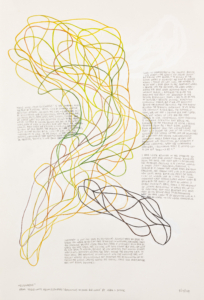POSTSCRIPT
Mark C. Taylor, a professor of Peter’s at Williams College and author of Field Notes on Elsewhere: Reflections on Living and Dying (the inspiration for the drawing Elsewhere included in Bibliography), shares his insights on Peter’s art:
Jacques Derrida once said to me, “It’s always been about death.” Having been born between a dead sister and a dead brother I never knew, and having myself died without dying, I understood Derrida’s point before he confided in me. I suspect that realization is what has always drawn me to his work.
A painting in muted tones entitled simply “India” by Peter Bruun hangs in my New York office. In my study in the Berkshires, I have one of his colorful pastel drawings of soldiers. What has always impressed me about these works is the way human figures are mingled – faces of countless people on the Indian subcontinent, human limbs of warring armies as intertwined as tightly as the tangled tropical forests where they fight. Who could have known in those early student years what pain and suffering lay ahead for Peter, for me, for our country, for our planet? For Peter too it’s always been about death – the death of his beloved daughter Elisif. Some wounds never heal.
If I had to choose a word for Peter’s impressive body of work, it would be Entanglement. As the years have passed, forms have slimmed to lines – entangled lines whose subtle colors figure the lives whose stories they tell. Words – poetry as well as prose, some Peter’s own, some borrowed from others, images, sounds that will continue to echo long after the speaker is gone. All woven together to create a text in which everything and everybody becomes a knot, a node in a tangled web that continues to expand. These graceful twisting and turning, curving and looping lines draw the viewer/reader into a seemingly eternal interplay that infinitely enlarges one’s being. The only art that matters is art that is redemptive.
Entangled lines weave a compelling alchemical tale that transforms darkness into light, and loss into love.
Have you ever said “Yes” to a single joy? O my friends, then you
Then you also said “Yes to all pain. All things are
Entwined, enmeshed, enamored –
Did you ever want Once to be Twice, did you
Ever say “I love you, bliss – instant, flash” – then
You wanted everything back.
Everything anew; everything forever, everything
Entwined, enmeshed, enamored – oh, thus you
Love the world
you everlasting ones, thus you love it forever
and for all time; for even to pain you say: Refrain but
come again. For joy accepts everlasting flow!*
In Peter Bruun’s entangled art, Midnight is Midday, and, in the words of the poet Merrit Malloy,
Love doesn’t die,
People do.
– Mark C. Taylor
* Freidrich Nietzsche, Thus Spoke Zarathustra
Peter’s painting India in Mark C. Taylor’s office.
Elsewhere, inspired by Mark C. Taylor’s writing. Explore the drawing in the online exhibition Bibliography.


